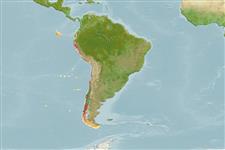Gastropoda |
Neogastropoda |
Nassariidae
Environment: milieu / climate zone / depth range / distribution range
Ecology
Benthic; depth range 0 - 100 m (Ref. 87801). Temperate
Southeast Pacific: Chile, Peru and Easter Island.
Length at first maturity / Size / Weight / Age
Maturity: Lm ? range ? - ? cm
It is found on sandy, muddy, gravel and pebble bottoms, in tide pools or associated with Mytilus beds, from the intertidal areas to a depth of 100 m. It feeds on dead animals and detritus (Ref. 87801).
Life cycle and mating behavior
Maturity | Reproduction | Spawning | Eggs | Fecundity | Larvae
This species is a non-broadcast spawner. Life cycle does not include trocophore stage. Also Ref. 833.
Häussermann, V. and G. Försterra 2009 Marine benthic fauna of Chilean Patagonia. Santiago, Nature in Focus. 1000 p. (Ref. 87801)
IUCN Red List Status
(Ref. 130435: Version 2025-1)
CITES status (Ref. 108899)
Not Evaluated
Not Evaluated
Threat to humans
Harmless
Human uses
| FishSource |
Tools
More information
Trophic EcologyFood items (preys)
Diet composition
Food consumption
Predators
Population dynamicsGrowth
Max. ages / sizes
Length-weight rel.
Length-length rel.
Length-frequencies
Mass conversion
Abundance
Life cycleReproductionMaturityFecunditySpawningEggsEgg developmentLarvae PhysiologyOxygen consumption
Human RelatedStamps, coins, misc.
Internet sources
Estimates based on models
Preferred temperature
(Ref.
115969): 10.3 - 21.2, mean 12 (based on 76 cells).
